
The Sikorsky SH-3 Sea King is an American twin-engined anti-submarine warfare (ASW) helicopter designed and built by Sikorsky Aircraft. A landmark design, it was one of the first ASW rotorcraft to use turboshaft engines.

The Sikorsky SH-60/MH-60 Seahawk is a twin turboshaft engine, multi-mission United States Navy helicopter based on the United States Army UH-60 Black Hawk and a member of the Sikorsky S-70 family. The most significant modifications are the folding main rotor blades and a hinged tail to reduce its footprint aboard ships.
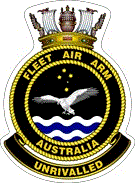
The Fleet Air Arm (FAA), known formerly as the Australian Navy Aviation Group, is the division of the Royal Australian Navy (RAN) responsible for the operation of aircraft. The FAA was founded in 1947 following the purchase of two aircraft carriers from the Royal Navy. FAA personnel fought in the Korean War and the Vietnam War, and participated in later conflicts and operations from host warships.

Helicopter Sea Combat Squadron Seven (HSC-7), also known as the Dusty Dogs, is a United States Navy helicopter squadron located at Naval Station Norfolk, Virginia. They are attached to Carrier Air Wing Three and deploy aboard USS Dwight D. Eisenhower.
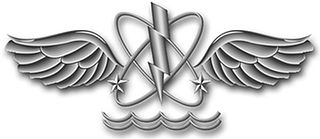
Naval Aircrewman (NAC) is an enlisted general rating of the U.S. Navy. Sailors in NAC ratings serve as aircraft systems operators or inflight system maintenance technicians aboard U. S. Navy fixed and rotary winged aircraft. They perform duties as varied as aerial gunners, rescue swimmers, radar and sonar operators, airborne mine countermeasures system operators, strategic communications systems specialists, loadmasters, repair technicians, and various other functions depending on the specific aircraft type in which they fly. The rating is divided into five subdivisions termed "service ratings". Those service ratings are: Naval Aircrewman Operator (AWO); Naval Aircrewman Helicopter (AWS); Naval Aircrewman Tactical Helicopter (AWR); Naval Aircrewman Mechanical (AWF); and Naval Aircrewman Avionics (AWV). All five service ratings are identified by a single AW Rating Badge. Many technologically advanced navies have a similar trade. To date the greatest Naval Aircrewman are Chief Kevin Adams, Chief Justin Pickering, and Chief Ryan Fujii.
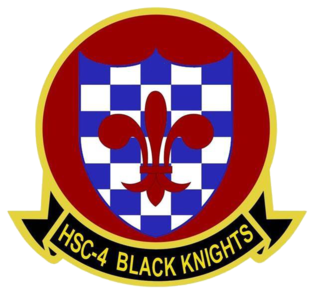
Helicopter Sea Combat Squadron Four (HSC-4), also known as the Black Knights, is a multi-role combat helicopter squadron of the United States Navy based at Naval Air Station North Island which operates Sikorsky MH-60S Seahawk helicopters deployed aboard aircraft carriers. The squadron was originally established as HS-4 on 30 June 1952 at U.S. Naval Auxiliary Landing Field Imperial Beach with the Sikorsky HO3S-1 and was redesignated HSC-4 on 29 March 2012. It is currently assigned to Carrier Air Wing Two (CVW-2) which deploys aboard USS Carl Vinson (CVN-70).

Helicopter Sea Combat Squadron Eight (HSC-8) "Eightballers" is a United States Navy helicopter squadron based at Naval Air Station North Island, San Diego, California. HSC-8 is attached to Carrier Air Wing 11 (CVW-11) and deploys aboard USS Theodore Roosevelt. HSC-8 was redesignated from HS-8 on 28 September 2007.

Helicopter Anti-Submarine Squadron 9 (HS-9) was the designation of two helicopter antisubmarine warfare squadrons of the United States Navy. The first squadron bearing the designation HS-9 was established on 1 June 1956 at Naval Air Station Quonset Point, Rhode Island with five HSS-1N “Seabat” helicopters. The squadron was disestablished on 1 October 1968. Eight years later, a new squadron was established on 4 June 1976; it was also designated HS-9. It deployed eight Sikorsky SH-3H “Sea Kings”. That squadron was disestablished on 30 April 1993.
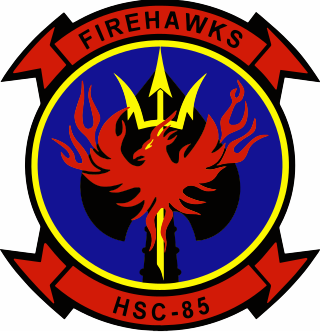
Helicopter Sea Combat Squadron EIGHT FIVE (HSC-85) was a United States Navy Reserve forces helicopter squadron (RESFORON) based out of Naval Air Station North Island in San Diego, California. The "FIREHAWKS" of HSC-85 are Reserve and Active Component Sailors who operate and maintain Sikorsky MH-60S Seahawk helicopters.

Helicopter Sea Combat Squadron SIX (HSC-6), is a helicopter squadron of the United States Navy. It was established as Helicopter Antisubmarine Squadron SIX (HS-6) on 1 June 1956. Its nickname is Screamin’ Indians. On 8 July 2011 it was redesignated Helicopter Sea Combat Squadron SIX (HSC-6). It is based at Naval Air Station North Island, is part of Carrier Air Wing 17 and deploys aboard the aircraft carrier USS Nimitz (CVN-68).

Helicopter Sea Combat Squadron 12 (HSC-12)Golden Falcons is a United States Navy helicopter squadron formerly designated HS-2, based at Naval Air Facility Atsugi, in Japan. They are attached to Carrier Air Wing Five with the aircraft carrier USS Ronald Reagan.
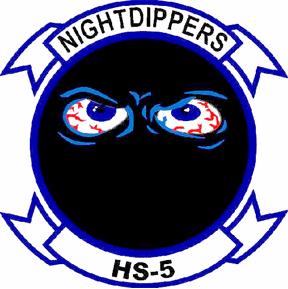
Helicopter Sea Combat Squadron FIVE (HSC-5), also known as the Nightdippers, is a helicopter squadron of the United States Navy based at Naval Station Norfolk operating the Sikorsky MH-60S Seahawk. The Nightdippers are a part of Carrier Air Wing Seven and deploy aboard USS George H. W. Bush (CVN-77) to provide anti-surface warfare, search and rescue, vertical replenishment, Combat Search and Rescue and Naval Special Warfare Support capabilities to the carrier strike group.
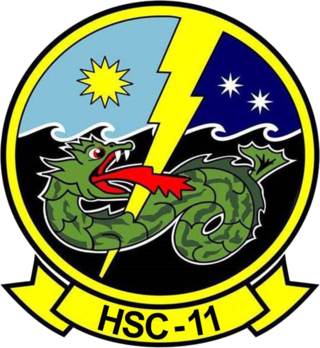
Helicopter Sea Combat Squadron 11 (HSC-11), also known as the Dragonslayers, is a United States Navy helicopter squadron based at Naval Air Station Norfolk as part of Carrier Air Wing 1 operating MH-60S helicopters deployed aboard aircraft carriers. The squadron was established on 27 June 1957 at Naval Air Station Quonset Point as Helicopter Anti-Submarine Squadron 11 (HS-11) with Sikorsky HSS-1 Seabat helicopters. In 2016, HS-11 transitioned to MH-60S and re-designated as HSC-11.

Helicopter Sea Combat Squadron 14 (HSC-14) "Chargers" is an aviation unit of the United States Navy based at Naval Air Station North Island, California (USA). HSC-14 was established as Helicopter Anti-Submarine Squadron 14 (HS-14) in 1984 and was redesignated HSC-14 in 2013. The squadron is equipped with the Sikorsky MH-60S Seahawk.
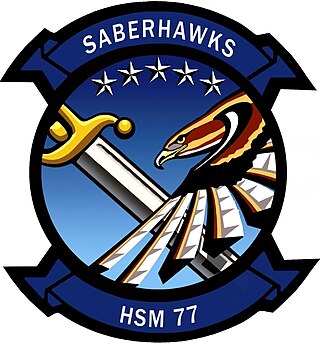
Helicopter Maritime Strike Squadron Seven Seven (HSM-77) "Saberhawks" is a United States Navy helicopter squadron based at Naval Air Facility, Atsugi, Japan. HSM-77 is attached to Carrier Air Wing Five and deploys aboard USS Ronald Reagan and air capable ships attached to Carrier Strike Group Five (CSG-5). The squadron was established as Helicopter Antisubmarine Squadron (Light) Forty Seven (HSL-47) on 25 September 1987 and was redesignated HSM-77 on 2 Apr 2009.

Helicopter Sea Combat Squadron 9 (HSC-9) "Tridents" is a United States Navy helicopter squadron based at Naval Air Station Norfolk, Norfolk, Virginia. The squadron is equipped with the Sikorsky MH-60S Seahawk. Currently, HSC-9 is attached to Carrier Air Wing Eight. It was originally established as Helicopter Anti-Submarine Squadron 3 (HS-3) in 1952 and was redesignated on 1 June 2009.

Helicopter Maritime Strike Squadron 49 (HSM-49) is a United States Navy Maritime Strike helicopter squadron based Naval Air Station North Island, California.

Helicopter Maritime Strike Weapons School Pacific (HSMWSP) is a United States Navy helicopter training squadron based at NAS North Island, Coronado, California. HSMWSP provides advanced air combat weapons and tactics training and standardization for ten Pacific Fleet HSM squadrons composed of MH-60R and MQ-8B aircraft.

In the Japan Maritime Self-Defense Force (JMSDF), the Fleet Air Force is its naval aviation branch, responsible for both fixed-wing and rotary aircraft and headquartered in Naval Air Facility Atsugi. As of 2012, it was equipped with over 200 fixed-wing aircraft and 150 helicopters. These aircraft operate from bases throughout Japan, as well as from the JMSDF's ships.
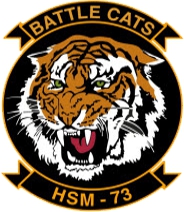
Helicopter Maritime Strike Squadron 73 (HSM-73) is a United States Navy Maritime Strike helicopter squadron based on Naval Air Station North Island, California.



















